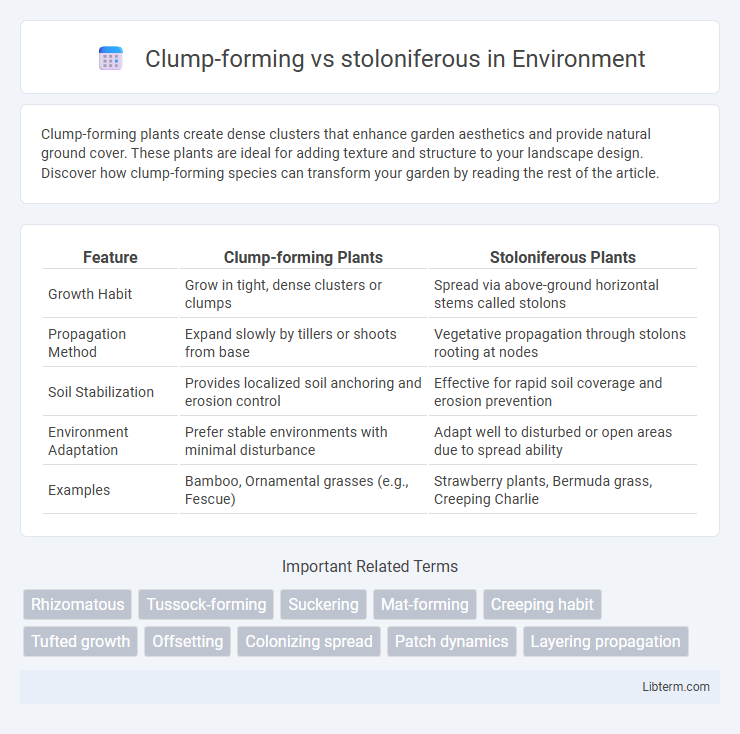Clump-forming plants create dense clusters that enhance garden aesthetics and provide natural ground cover. These plants are ideal for adding texture and structure to your landscape design. Discover how clump-forming species can transform your garden by reading the rest of the article.
Table of Comparison
| Feature | Clump-forming Plants | Stoloniferous Plants |
|---|---|---|
| Growth Habit | Grow in tight, dense clusters or clumps | Spread via above-ground horizontal stems called stolons |
| Propagation Method | Expand slowly by tillers or shoots from base | Vegetative propagation through stolons rooting at nodes |
| Soil Stabilization | Provides localized soil anchoring and erosion control | Effective for rapid soil coverage and erosion prevention |
| Environment Adaptation | Prefer stable environments with minimal disturbance | Adapt well to disturbed or open areas due to spread ability |
| Examples | Bamboo, Ornamental grasses (e.g., Fescue) | Strawberry plants, Bermuda grass, Creeping Charlie |
Introduction to Grass Growth Habits
Grass growth habits vary primarily between clump-forming and stoloniferous types, which influence their spreading and maintenance. Clump-forming grasses grow in dense tufts, expanding slowly through tillers, making them ideal for low-maintenance landscapes with minimal invasion. Stoloniferous grasses spread rapidly via horizontal above-ground stems called stolons, promoting quick ground coverage and improved erosion control.
What is Clump-forming Grass?
Clump-forming grass grows in tight, dense tufts or bunches, with new shoots developing closely around the base, limiting horizontal spread. This growth habit helps control erosion by stabilizing soil while requiring less maintenance to prevent invasion. Clump-forming species such as fescue and buffalo grass provide durable turf ideal for landscaping and low-water environments.
Overview of Stoloniferous Grasses
Stoloniferous grasses propagate through above-ground horizontal stems called stolons, enabling rapid surface spreading and ground coverage. These grasses excel in erosion control and turf establishment due to their aggressive growth habit and ability to root at nodes. Common examples include Bermuda grass and creeping bentgrass, valued for durability and resilience in landscaping and sports fields.
Key Differences: Clump-forming vs. Stoloniferous
Clump-forming plants grow in dense, tufted clusters by producing new shoots from a central crown, which leads to a compact growth habit ideal for groundcover and erosion control. Stoloniferous plants spread through horizontal above-ground stems called stolons, which root at nodes to form new plants, enabling rapid area colonization and aggressive spreading. The key difference lies in their propagation method--clump-forming plants expand mainly upwards and outwards from a single base, while stoloniferous species extend horizontally to create new, genetically identical individuals.
Growth Patterns and Lawn Density
Clump-forming grasses grow in tight, tufted bunches, leading to moderate lawn density and allowing for better air circulation between shoots. Stoloniferous grasses spread horizontally through above-ground runners called stolons, which root at nodes to create dense and uniform turf coverage. This growth pattern results in quicker lawn fill-in and improved erosion control compared to clump-forming varieties.
Maintenance Requirements Compared
Clump-forming plants generally require less maintenance due to their compact growth habit, reducing the need for frequent pruning and dividing. Stoloniferous plants spread via runners, demanding regular control to manage their horizontal expansion and prevent overcrowding. Consequently, clump-forming varieties are often preferred for low-maintenance landscapes, while stoloniferous types need consistent monitoring to maintain tidy growth.
Best Uses for Clump-forming Grasses
Clump-forming grasses excel in erosion control and landscaping where defined, stable plant groups are preferred, creating dense, manageable tufts that prevent soil loss on slopes and embankments. They suit ornamental gardens and naturalistic plantings by providing structured, low-maintenance ground cover with minimal spreading, ideal for pathways and borders. Their extensive root systems improve soil stability, making them optimal for restoration projects and areas requiring sustainable vegetation management.
Ideal Applications for Stoloniferous Grasses
Stoloniferous grasses, characterized by their above-ground runners, are ideal for quickly establishing ground cover in erosion-prone areas and high-traffic zones such as sports fields and parks. Their ability to spread horizontally aids in filling bare spots efficiently, promoting soil stabilization and reducing weed invasion. These grasses thrive in environments requiring rapid vegetative propagation and consistent turf density.
Choosing the Right Grass for Your Landscape
Choosing between clump-forming and stoloniferous grasses depends on your landscape goals and maintenance preferences. Clump-forming grasses grow in tight clusters, providing excellent soil stabilization and minimal spreading, ideal for erosion control and defined borders. Stoloniferous grasses spread via above-ground runners, quickly covering large areas, making them perfect for lawns needing fast coverage and weed suppression.
Conclusion: Which Grass Type Suits Your Needs?
Clump-forming grasses provide dense growth ideal for erosion control and low-maintenance landscaping, while stoloniferous grasses spread rapidly, creating a uniform turf suitable for high-traffic areas and sports fields. Selecting the right grass depends on factors like soil type, maintenance capacity, and usage intensity. For durable, quick-cover lawns, stoloniferous varieties excel; for ornamental and drought-resistant planting, clump-forming grasses are preferable.
Clump-forming Infographic

 libterm.com
libterm.com